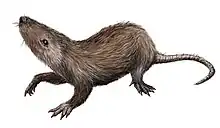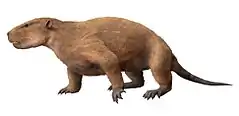Ameribaatar
Ameribaatar is an extinct mammal of the Late Cretaceous. It was a member of the also extinct order of Multituberculata. It lived in North America during the Mesozoic, also known as the "age of the dinosaurs". Whether it belongs to Plagiaulacida, Cimolodonta, or neither, is unclear. The genus Ameribaatar ("American hero") was named by Eaton and Cifelli in 2001.
| Ameribaatar Temporal range: Late Cretaceous | |
|---|---|
| Scientific classification | |
| Domain: | Eukaryota |
| Kingdom: | Animalia |
| Phylum: | Chordata |
| Class: | Mammalia |
| Order: | †Multituberculata |
| Family: | †incertae sedis |
| Genus: | †Ameribaatar Eaton and Cifelli, 2001 |
| Species | |
The type species is Ameribaatar zofiae. Its fossil remains were discovered in strata dating to the Albian-Cenomanian boundary (also the Lower-Upper Cretaceous boundary) in the Cedar Mountain Formation, Utah (USA).
The species name honours Zofia Kielan-Jaworowska.
References
- Dykes, Trevor (2001–2009). "MESOZOIC MAMMALS; Basal Multituberculata, an Internet directory". Archived from the original on 14 May 2011. Retrieved 14 May 2011.
- Eaton, Jeffrey G; Cifelli, Richard L (2001). "Multituberculate mammals from near the Early-Late Cretaceous boundary, Cedar Mountain Formation, Utah" (PDF). Acta Palaeontologica Polonica. 46 (4): 453–518.
This article is issued from Wikipedia. The text is licensed under Creative Commons - Attribution - Sharealike. Additional terms may apply for the media files.

